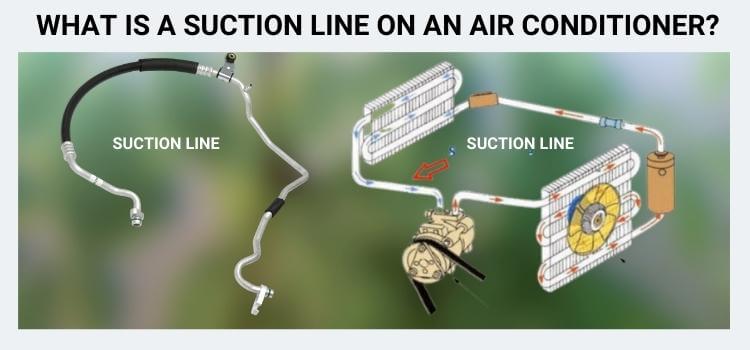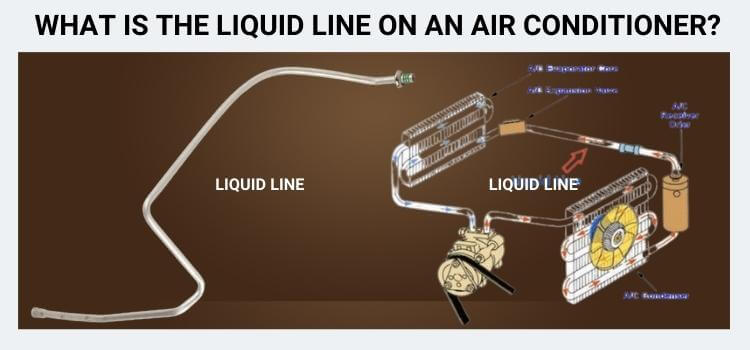As an Amazon Associate I earn from qualifying purchases.

When it comes to air conditioners, understanding their various components and how they work together is crucial. One such vital component is the suction line. This comprehensive guide delves into what a suction line is, its significance in air conditioning systems, and its role in cooling. Let’s embark on this informative journey and unravel the mysteries of the suction line.
What is a Suction Line on an Air Conditioner?
A suction line is a copper tube that carries refrigerant from the evaporator coil to the compressor in an air conditioner. The refrigerant is vaporized when it enters the suction line and is under low pressure. As the refrigerant flows through the suction line, it absorbs heat from the surrounding air. This causes the refrigerant to condense and become a liquid. The liquid refrigerant then flows into the compressor, which is compressed and sent back to the evaporator coil.
The suction line is typically insulated to prevent heat loss. This is important because the refrigerant is very cold, and if it loses heat, it will not be able to absorb as much heat from the air.
The suction line is also typically larger in diameter than the liquid line. The refrigerant is under lower pressure in the suction line, so it needs a larger diameter to flow through.
If the suction line is damaged, it can cause the air conditioner to lose refrigerant. This will reduce the air conditioner’s efficiency and may cause it to stop working altogether. If you suspect the suction line is damaged, call a qualified HVAC technician to repair it.
Here are some of the signs that the suction line in your air conditioner may be damaged:
- Your air conditioner used to be more relaxed than it is now.
- You hear a hissing sound coming from the air conditioner.
- You see water dripping from the air conditioner.
- You can see frost on the evaporator coil.
Call a qualified HVAC technician to inspect your air conditioner if you notice any of these signs.
The Importance of the Suction Line
The suction line is essential to any refrigeration or air conditioning system. It carries the refrigerant from the evaporator coil to the compressor. The refrigerant is vaporized when it enters the suction line and is under low pressure. As the refrigerant flows through the suction line, it absorbs heat from the surrounding air. This causes the refrigerant to condense and become a liquid. The liquid refrigerant then flows into the compressor, which is compressed and sent back to the evaporator coil.
The suction line is typically insulated to prevent heat loss. This is important because the refrigerant is very cold, and if it loses heat, it will not be able to absorb as much heat from the air.
The suction line is also typically larger in diameter than the liquid line. The refrigerant is under lower pressure in the suction line, so it needs a larger diameter to flow through.
If the suction line is damaged, it can cause the air conditioner to lose refrigerant. This will reduce the air conditioner’s efficiency and may cause it to stop working altogether. If you suspect the suction line is damaged, call a qualified HVAC technician to repair it.
Here are some of the reasons why the suction line is essential:
- It carries the refrigerant from the evaporator coil to the compressor.
- It is typically larger in diameter than the liquid line.
- If it is damaged, it can cause the air conditioner to lose refrigerant.
Here are some tips for maintaining the suction line:
- Keep the suction line clean and free of debris.
- Inspect the suction line for leaks regularly.
- If the suction line is damaged, have it repaired by a qualified HVAC technician?
By following these tips, you can help ensure that the suction line in your air conditioner is in good condition and that your air conditioner is operating efficiently.
How the Suction Line Works
The suction line in an air conditioner works by carrying the refrigerant from the evaporator coil to the compressor. The refrigerant is vaporized when it enters the suction line and is under low pressure. As the refrigerant flows through the suction line, it absorbs heat from the surrounding air. This causes the refrigerant to condense and become a liquid. The liquid refrigerant then flows into the compressor, which is compressed and sent back to the evaporator coil.
The suction line is typically insulated to prevent heat loss. This is important because the refrigerant is very cold, and if it loses heat, it will not be able to absorb as much heat from the air.
The suction line is also typically larger in diameter than the liquid line. The refrigerant is under lower pressure in the suction line, so it needs a larger diameter to flow through.
Here is a step-by-step explanation of how the suction line works:
- The refrigerant evaporates in the evaporator coil.
- The low-pressure refrigerant vapor enters the suction line.
- The suction line carries the refrigerant smoke to the compressor.
- The compressor compresses the refrigerant vapor.
- The high-pressure refrigerant vapor exits the compressor.
- The high-pressure refrigerant vapor enters the condenser coil.
- The condenser coil cools the refrigerant smoke.
- The refrigerant vapor condenses into a liquid.
- The cycle repeats.
The suction line is essential to the air conditioning system and vital in cooling. If the suction line is damaged, it can cause the air conditioner to lose refrigerant and become inefficient. Suppose you suspect that the suction line in your air conditioner is damaged. In that case, you should call a qualified HVAC technician to inspect it.
Components of the Suction Line
The suction line comprises several essential components that facilitate its functionality and efficiency. These include:
Suction Line Pipe
The suction line pipe is a metal tube through which the gaseous refrigerant flows. It is typically made of copper or aluminum due to its excellent heat transfer properties. The pipe’s size and length are crucial in maintaining the appropriate refrigerant flow and pressure.
Suction Line Insulation
The suction line is often covered to maintain the refrigerant at the desired temperature. This insulation material helps to minimize heat exchange with the surrounding environment, ensuring that the refrigerant remains in its gaseous state until it reaches the compressor.
Suction Line Filter
A suction-line filter ensures the refrigerant is free from contaminants and debris. This filter traps particles that might have entered the system during installation or maintenance, protecting the compressor and other components from potential damage.
Suction Line Accumulator
The suction line accumulator serves as a reservoir for the refrigerant, ensuring a consistent flow to the compressor. It separates any remaining liquid refrigerant from the gaseous refrigerant, preventing any liquid slugging that could harm the compressor.
Common Issues with Suction Lines
While the suction line is a critical component in air conditioning systems, it has its share of problems. Some common issues include:
Refrigerant Leaks
The suction line may eventually have leaks due to wear and tear or faulty installation. These leaks can lead to decreased cooling efficiency and may necessitate a refrigerant recharge.
Insufficient Insulation
Suppose the suction line insulation is damaged or inadequate. In that case, heat gain can occur, causing the refrigerant to change state prematurely and affecting the overall cooling performance.
Clogging of Suction Line Filter
A clogged suction line filter can restrict refrigerant flow, reducing cooling capacity and potential compressor issues.
FAQs
While experienced individuals can replace a damaged suction line, it is recommended to seek professional assistance. Handling refrigerants and complex AC components requires expertise to avoid potential hazards and ensure the system’s proper functioning.
Suction line insulation helps maintain the refrigerant’s temperature. It prevents heat gain, ensuring the refrigerant remains gaseous until it reaches the compressor.
Refrigerant leaks in the suction line can occur due to corrosion, physical damage, or poor installation practices. Regular upkeep may aid in spotting and resolving possible leak problems.
A clogged suction line filter can be a common issue, especially in systems without regular maintenance. Regularly inspecting and cleaning the filter can help prevent this problem. Dirt, debris, mold, and algae buildup. Regular maintenance can help prevent frequent clogs.
To ensure the efficiency of the suction line, schedule regular maintenance and inspections with a certified HVAC professional. Keep the area around the suction line clear and keep the insulation intact.
Yes, a damaged suction line can lead to refrigerant leaks and a decrease in cooling capacity. It may also cause the compressor to work harder, potentially leading to further issues.
Conclusion
In conclusion, the suction line is a crucial component of an air conditioner, playing a pivotal role in the refrigeration cycle and ensuring efficient cooling of indoor spaces. Understanding its importance, features, and potential issues can help homeowners and HVAC professionals maintain their cooling systems and optimize their performance.
Remember, a well-maintained suction line contributes to an air conditioner’s longevity and energy efficiency, saving you both money and discomfort. If you encounter any issues with your air conditioning system, consult a certified HVAC technician to ensure safe and effective repairs.
Related Post
Amazon and the Amazon logo are trademarks of Amazon.com, Inc, or its affiliates.




Leave a Reply